An In-Depth Essay on International Human Resource Management
VerifiedAdded on 2023/01/06
|13
|3400
|79
Essay
AI Summary
This essay delves into the multifaceted realm of International Human Resource Management (IHRM), exploring its core concepts, theories, and practical applications. The essay begins by defining IHRM and distinguishing it from domestic HRM, highlighting the increased complexity and global scope of IHRM. It then examines critical models such as the multicultural model, emphasizing the importance of diversity and cultural sensitivity in managing a global workforce. The essay also discusses the convergence and divergence theory, exploring how organizations balance global standardization with local adaptation in HR practices. Furthermore, the essay analyzes the Harvard Model of Human Resource Management, adapting it to the international context. By addressing challenges like diversity, recruitment, and employee management, the essay underscores the significance of IHRM in achieving organizational objectives and maintaining a competitive advantage in the international business arena. The essay concludes by emphasizing the role of IHRM in navigating socio-cultural, political, and economic dynamics, making it an essential component of international business strategy. The essay provides a comprehensive overview of the key concepts and theories, and is intended to provide insight into the complexities of managing human capital on a global scale.
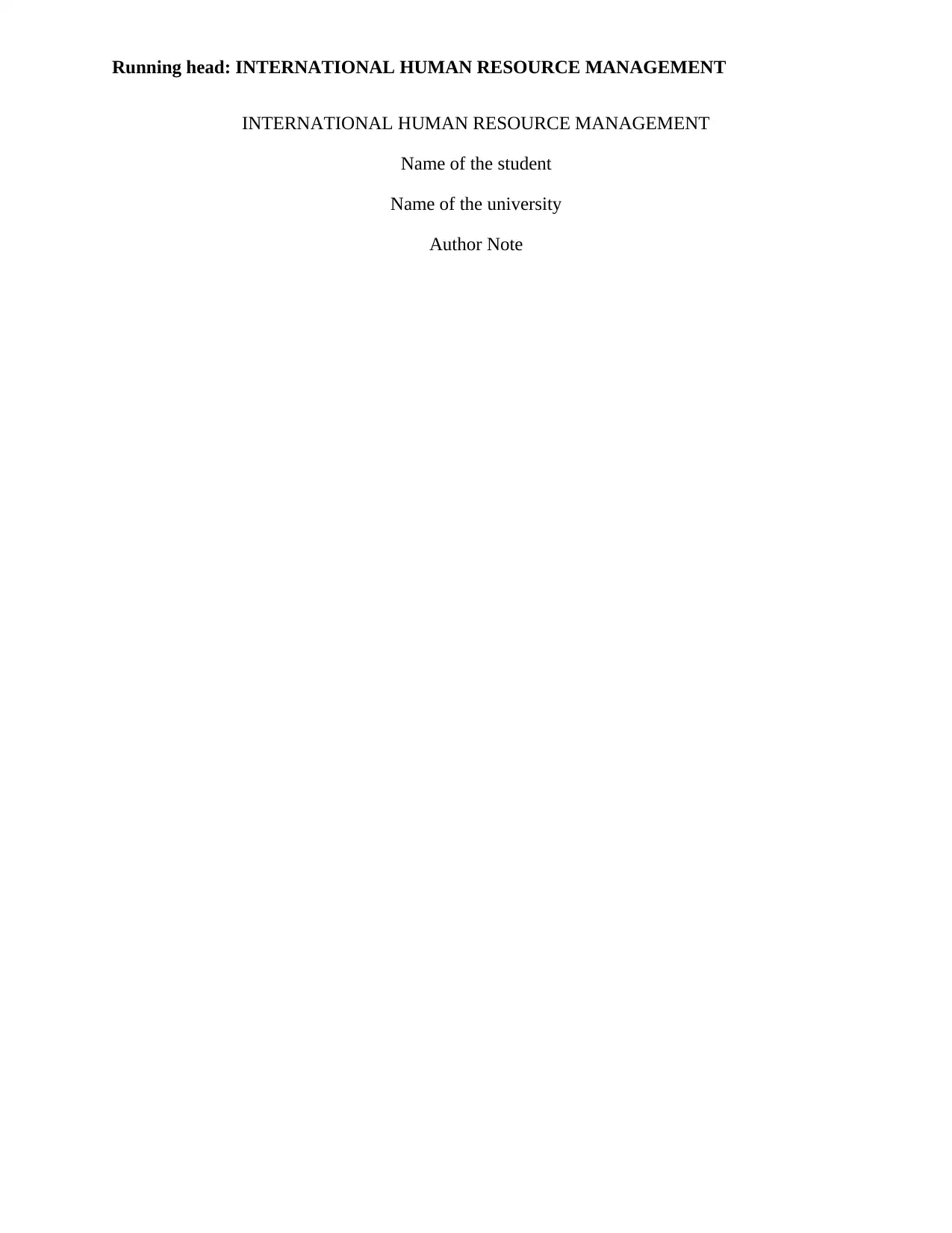
Running head: INTERNATIONAL HUMAN RESOURCE MANAGEMENT
INTERNATIONAL HUMAN RESOURCE MANAGEMENT
Name of the student
Name of the university
Author Note
INTERNATIONAL HUMAN RESOURCE MANAGEMENT
Name of the student
Name of the university
Author Note
Paraphrase This Document
Need a fresh take? Get an instant paraphrase of this document with our AI Paraphraser
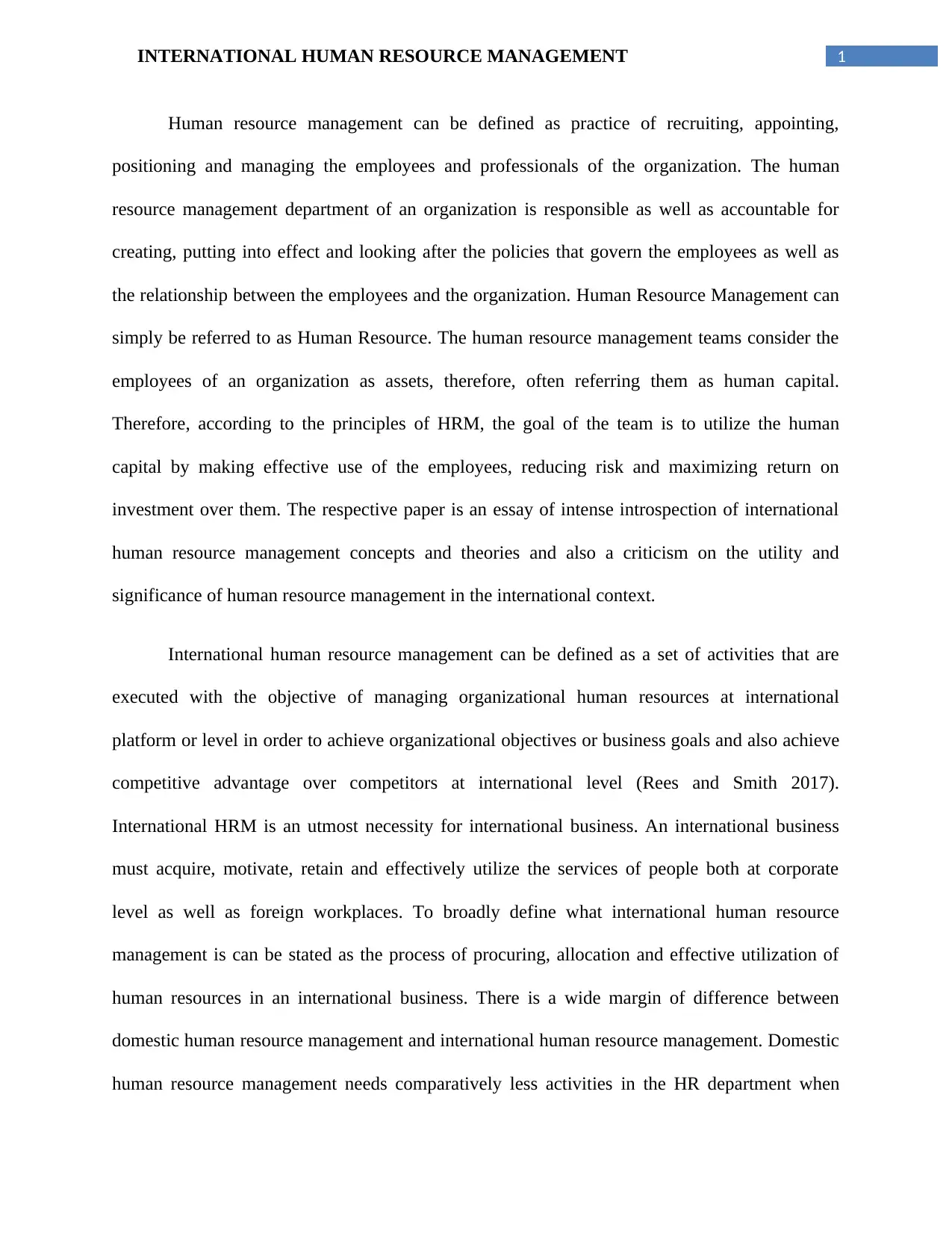
1INTERNATIONAL HUMAN RESOURCE MANAGEMENT
Human resource management can be defined as practice of recruiting, appointing,
positioning and managing the employees and professionals of the organization. The human
resource management department of an organization is responsible as well as accountable for
creating, putting into effect and looking after the policies that govern the employees as well as
the relationship between the employees and the organization. Human Resource Management can
simply be referred to as Human Resource. The human resource management teams consider the
employees of an organization as assets, therefore, often referring them as human capital.
Therefore, according to the principles of HRM, the goal of the team is to utilize the human
capital by making effective use of the employees, reducing risk and maximizing return on
investment over them. The respective paper is an essay of intense introspection of international
human resource management concepts and theories and also a criticism on the utility and
significance of human resource management in the international context.
International human resource management can be defined as a set of activities that are
executed with the objective of managing organizational human resources at international
platform or level in order to achieve organizational objectives or business goals and also achieve
competitive advantage over competitors at international level (Rees and Smith 2017).
International HRM is an utmost necessity for international business. An international business
must acquire, motivate, retain and effectively utilize the services of people both at corporate
level as well as foreign workplaces. To broadly define what international human resource
management is can be stated as the process of procuring, allocation and effective utilization of
human resources in an international business. There is a wide margin of difference between
domestic human resource management and international human resource management. Domestic
human resource management needs comparatively less activities in the HR department when
Human resource management can be defined as practice of recruiting, appointing,
positioning and managing the employees and professionals of the organization. The human
resource management department of an organization is responsible as well as accountable for
creating, putting into effect and looking after the policies that govern the employees as well as
the relationship between the employees and the organization. Human Resource Management can
simply be referred to as Human Resource. The human resource management teams consider the
employees of an organization as assets, therefore, often referring them as human capital.
Therefore, according to the principles of HRM, the goal of the team is to utilize the human
capital by making effective use of the employees, reducing risk and maximizing return on
investment over them. The respective paper is an essay of intense introspection of international
human resource management concepts and theories and also a criticism on the utility and
significance of human resource management in the international context.
International human resource management can be defined as a set of activities that are
executed with the objective of managing organizational human resources at international
platform or level in order to achieve organizational objectives or business goals and also achieve
competitive advantage over competitors at international level (Rees and Smith 2017).
International HRM is an utmost necessity for international business. An international business
must acquire, motivate, retain and effectively utilize the services of people both at corporate
level as well as foreign workplaces. To broadly define what international human resource
management is can be stated as the process of procuring, allocation and effective utilization of
human resources in an international business. There is a wide margin of difference between
domestic human resource management and international human resource management. Domestic
human resource management needs comparatively less activities in the HR department when
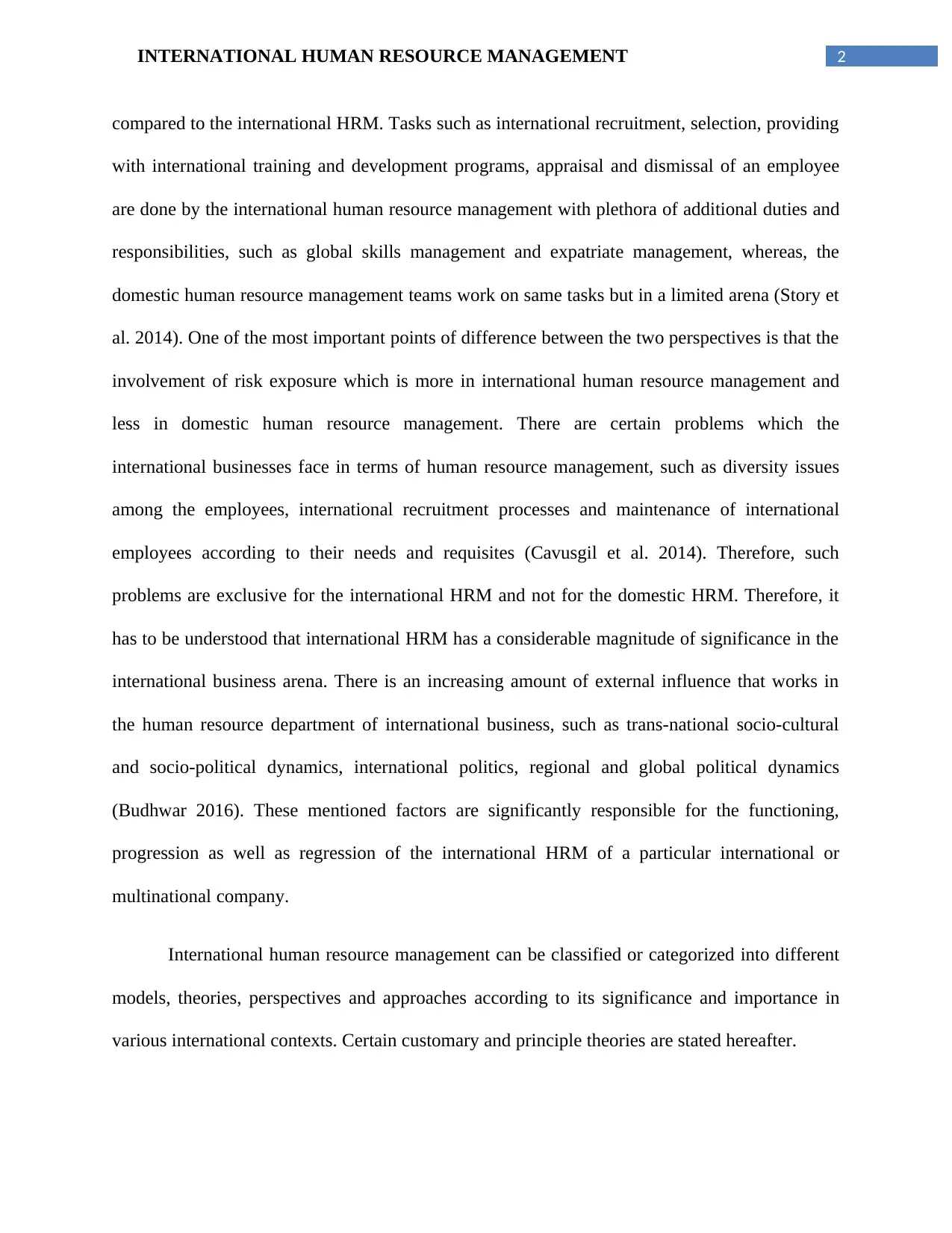
2INTERNATIONAL HUMAN RESOURCE MANAGEMENT
compared to the international HRM. Tasks such as international recruitment, selection, providing
with international training and development programs, appraisal and dismissal of an employee
are done by the international human resource management with plethora of additional duties and
responsibilities, such as global skills management and expatriate management, whereas, the
domestic human resource management teams work on same tasks but in a limited arena (Story et
al. 2014). One of the most important points of difference between the two perspectives is that the
involvement of risk exposure which is more in international human resource management and
less in domestic human resource management. There are certain problems which the
international businesses face in terms of human resource management, such as diversity issues
among the employees, international recruitment processes and maintenance of international
employees according to their needs and requisites (Cavusgil et al. 2014). Therefore, such
problems are exclusive for the international HRM and not for the domestic HRM. Therefore, it
has to be understood that international HRM has a considerable magnitude of significance in the
international business arena. There is an increasing amount of external influence that works in
the human resource department of international business, such as trans-national socio-cultural
and socio-political dynamics, international politics, regional and global political dynamics
(Budhwar 2016). These mentioned factors are significantly responsible for the functioning,
progression as well as regression of the international HRM of a particular international or
multinational company.
International human resource management can be classified or categorized into different
models, theories, perspectives and approaches according to its significance and importance in
various international contexts. Certain customary and principle theories are stated hereafter.
compared to the international HRM. Tasks such as international recruitment, selection, providing
with international training and development programs, appraisal and dismissal of an employee
are done by the international human resource management with plethora of additional duties and
responsibilities, such as global skills management and expatriate management, whereas, the
domestic human resource management teams work on same tasks but in a limited arena (Story et
al. 2014). One of the most important points of difference between the two perspectives is that the
involvement of risk exposure which is more in international human resource management and
less in domestic human resource management. There are certain problems which the
international businesses face in terms of human resource management, such as diversity issues
among the employees, international recruitment processes and maintenance of international
employees according to their needs and requisites (Cavusgil et al. 2014). Therefore, such
problems are exclusive for the international HRM and not for the domestic HRM. Therefore, it
has to be understood that international HRM has a considerable magnitude of significance in the
international business arena. There is an increasing amount of external influence that works in
the human resource department of international business, such as trans-national socio-cultural
and socio-political dynamics, international politics, regional and global political dynamics
(Budhwar 2016). These mentioned factors are significantly responsible for the functioning,
progression as well as regression of the international HRM of a particular international or
multinational company.
International human resource management can be classified or categorized into different
models, theories, perspectives and approaches according to its significance and importance in
various international contexts. Certain customary and principle theories are stated hereafter.
⊘ This is a preview!⊘
Do you want full access?
Subscribe today to unlock all pages.

Trusted by 1+ million students worldwide
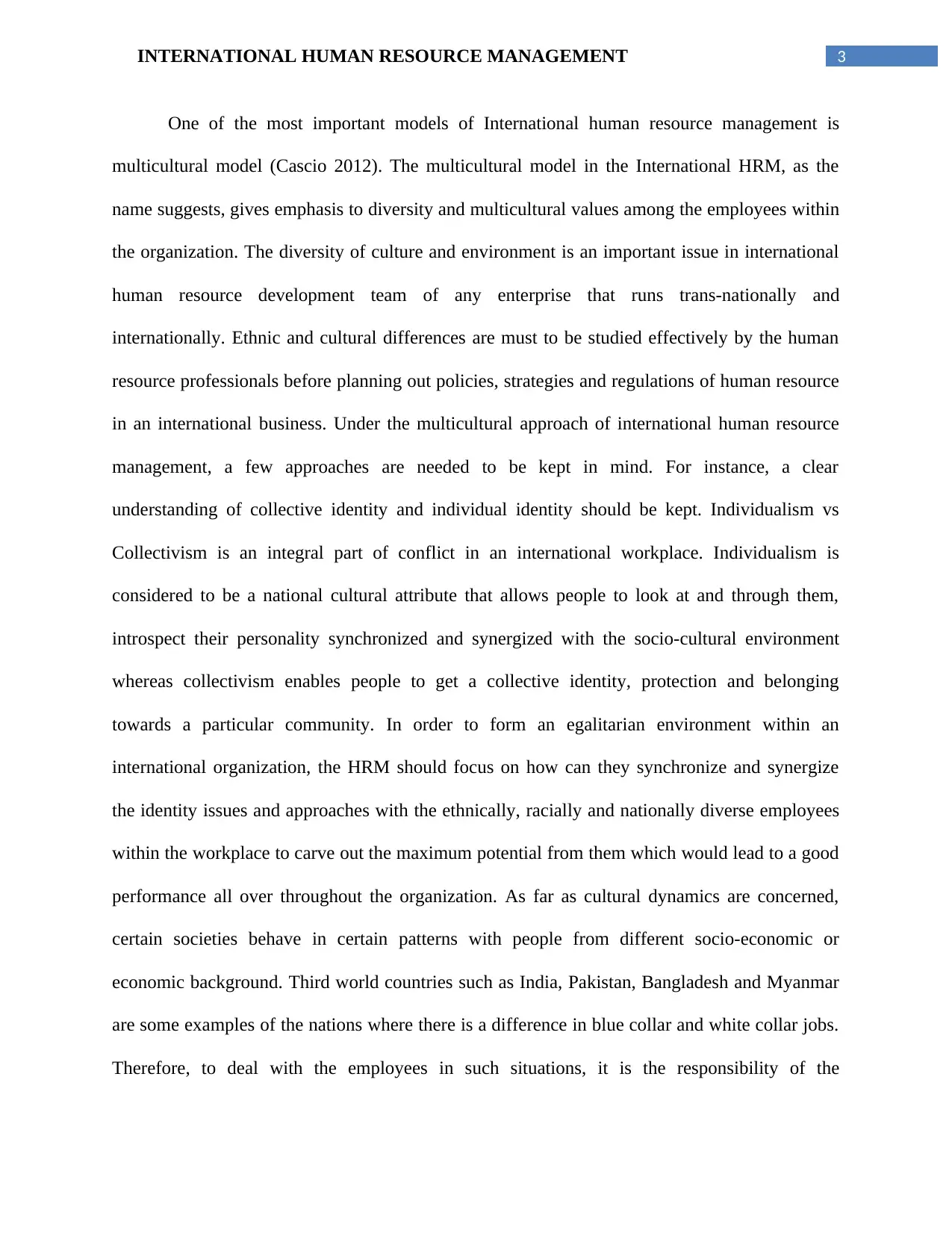
3INTERNATIONAL HUMAN RESOURCE MANAGEMENT
One of the most important models of International human resource management is
multicultural model (Cascio 2012). The multicultural model in the International HRM, as the
name suggests, gives emphasis to diversity and multicultural values among the employees within
the organization. The diversity of culture and environment is an important issue in international
human resource development team of any enterprise that runs trans-nationally and
internationally. Ethnic and cultural differences are must to be studied effectively by the human
resource professionals before planning out policies, strategies and regulations of human resource
in an international business. Under the multicultural approach of international human resource
management, a few approaches are needed to be kept in mind. For instance, a clear
understanding of collective identity and individual identity should be kept. Individualism vs
Collectivism is an integral part of conflict in an international workplace. Individualism is
considered to be a national cultural attribute that allows people to look at and through them,
introspect their personality synchronized and synergized with the socio-cultural environment
whereas collectivism enables people to get a collective identity, protection and belonging
towards a particular community. In order to form an egalitarian environment within an
international organization, the HRM should focus on how can they synchronize and synergize
the identity issues and approaches with the ethnically, racially and nationally diverse employees
within the workplace to carve out the maximum potential from them which would lead to a good
performance all over throughout the organization. As far as cultural dynamics are concerned,
certain societies behave in certain patterns with people from different socio-economic or
economic background. Third world countries such as India, Pakistan, Bangladesh and Myanmar
are some examples of the nations where there is a difference in blue collar and white collar jobs.
Therefore, to deal with the employees in such situations, it is the responsibility of the
One of the most important models of International human resource management is
multicultural model (Cascio 2012). The multicultural model in the International HRM, as the
name suggests, gives emphasis to diversity and multicultural values among the employees within
the organization. The diversity of culture and environment is an important issue in international
human resource development team of any enterprise that runs trans-nationally and
internationally. Ethnic and cultural differences are must to be studied effectively by the human
resource professionals before planning out policies, strategies and regulations of human resource
in an international business. Under the multicultural approach of international human resource
management, a few approaches are needed to be kept in mind. For instance, a clear
understanding of collective identity and individual identity should be kept. Individualism vs
Collectivism is an integral part of conflict in an international workplace. Individualism is
considered to be a national cultural attribute that allows people to look at and through them,
introspect their personality synchronized and synergized with the socio-cultural environment
whereas collectivism enables people to get a collective identity, protection and belonging
towards a particular community. In order to form an egalitarian environment within an
international organization, the HRM should focus on how can they synchronize and synergize
the identity issues and approaches with the ethnically, racially and nationally diverse employees
within the workplace to carve out the maximum potential from them which would lead to a good
performance all over throughout the organization. As far as cultural dynamics are concerned,
certain societies behave in certain patterns with people from different socio-economic or
economic background. Third world countries such as India, Pakistan, Bangladesh and Myanmar
are some examples of the nations where there is a difference in blue collar and white collar jobs.
Therefore, to deal with the employees in such situations, it is the responsibility of the
Paraphrase This Document
Need a fresh take? Get an instant paraphrase of this document with our AI Paraphraser
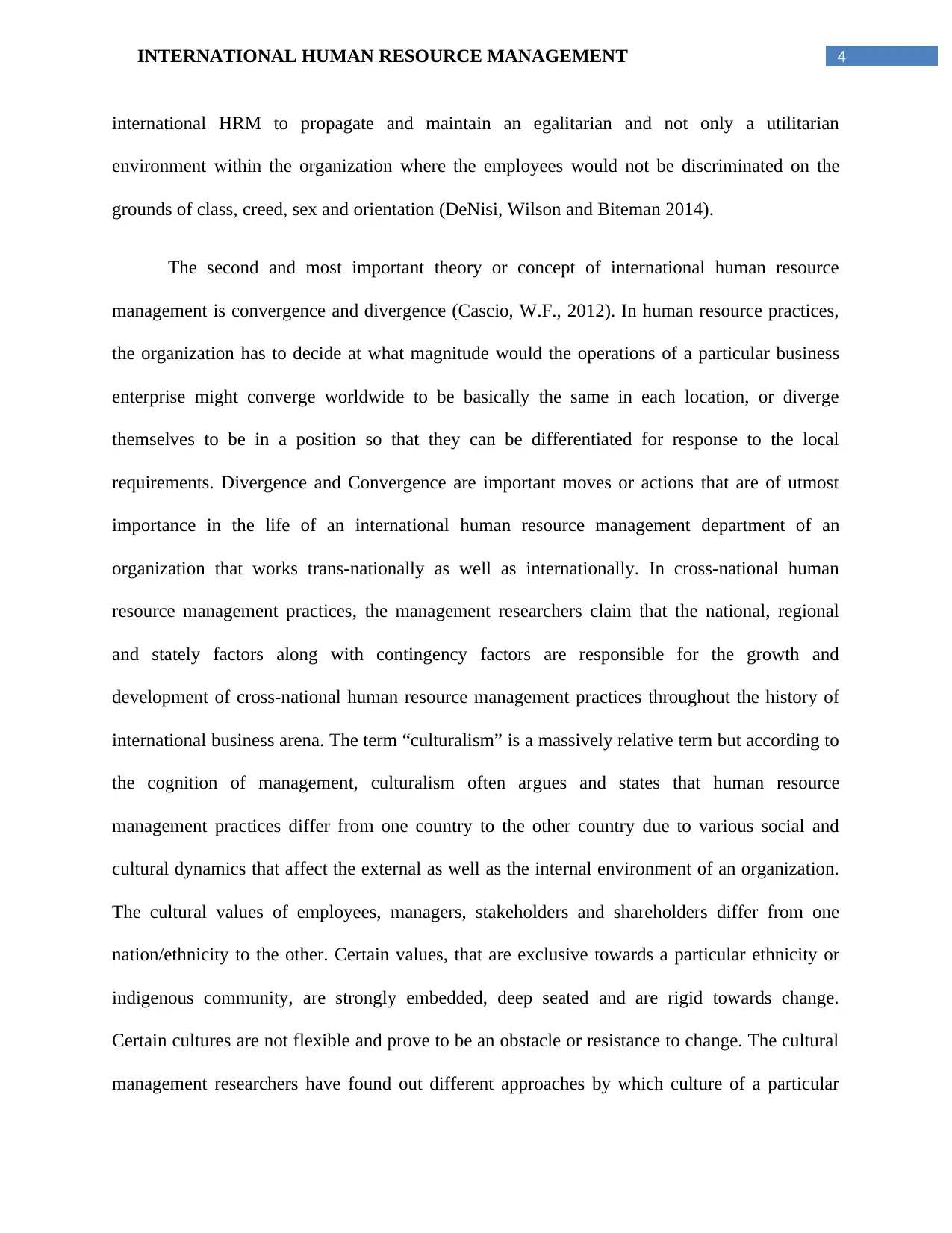
4INTERNATIONAL HUMAN RESOURCE MANAGEMENT
international HRM to propagate and maintain an egalitarian and not only a utilitarian
environment within the organization where the employees would not be discriminated on the
grounds of class, creed, sex and orientation (DeNisi, Wilson and Biteman 2014).
The second and most important theory or concept of international human resource
management is convergence and divergence (Cascio, W.F., 2012). In human resource practices,
the organization has to decide at what magnitude would the operations of a particular business
enterprise might converge worldwide to be basically the same in each location, or diverge
themselves to be in a position so that they can be differentiated for response to the local
requirements. Divergence and Convergence are important moves or actions that are of utmost
importance in the life of an international human resource management department of an
organization that works trans-nationally as well as internationally. In cross-national human
resource management practices, the management researchers claim that the national, regional
and stately factors along with contingency factors are responsible for the growth and
development of cross-national human resource management practices throughout the history of
international business arena. The term “culturalism” is a massively relative term but according to
the cognition of management, culturalism often argues and states that human resource
management practices differ from one country to the other country due to various social and
cultural dynamics that affect the external as well as the internal environment of an organization.
The cultural values of employees, managers, stakeholders and shareholders differ from one
nation/ethnicity to the other. Certain values, that are exclusive towards a particular ethnicity or
indigenous community, are strongly embedded, deep seated and are rigid towards change.
Certain cultures are not flexible and prove to be an obstacle or resistance to change. The cultural
management researchers have found out different approaches by which culture of a particular
international HRM to propagate and maintain an egalitarian and not only a utilitarian
environment within the organization where the employees would not be discriminated on the
grounds of class, creed, sex and orientation (DeNisi, Wilson and Biteman 2014).
The second and most important theory or concept of international human resource
management is convergence and divergence (Cascio, W.F., 2012). In human resource practices,
the organization has to decide at what magnitude would the operations of a particular business
enterprise might converge worldwide to be basically the same in each location, or diverge
themselves to be in a position so that they can be differentiated for response to the local
requirements. Divergence and Convergence are important moves or actions that are of utmost
importance in the life of an international human resource management department of an
organization that works trans-nationally as well as internationally. In cross-national human
resource management practices, the management researchers claim that the national, regional
and stately factors along with contingency factors are responsible for the growth and
development of cross-national human resource management practices throughout the history of
international business arena. The term “culturalism” is a massively relative term but according to
the cognition of management, culturalism often argues and states that human resource
management practices differ from one country to the other country due to various social and
cultural dynamics that affect the external as well as the internal environment of an organization.
The cultural values of employees, managers, stakeholders and shareholders differ from one
nation/ethnicity to the other. Certain values, that are exclusive towards a particular ethnicity or
indigenous community, are strongly embedded, deep seated and are rigid towards change.
Certain cultures are not flexible and prove to be an obstacle or resistance to change. The cultural
management researchers have found out different approaches by which culture of a particular
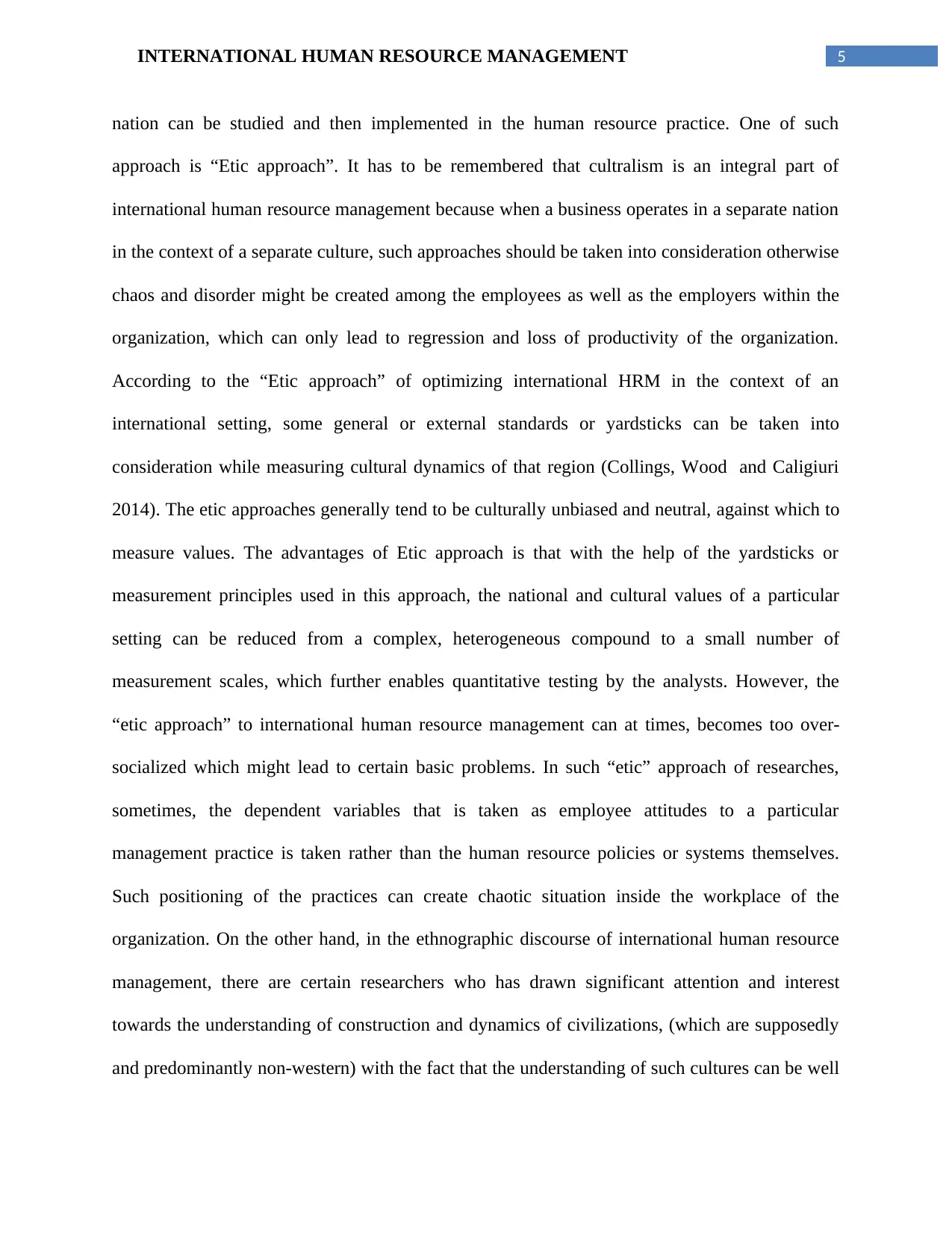
5INTERNATIONAL HUMAN RESOURCE MANAGEMENT
nation can be studied and then implemented in the human resource practice. One of such
approach is “Etic approach”. It has to be remembered that cultralism is an integral part of
international human resource management because when a business operates in a separate nation
in the context of a separate culture, such approaches should be taken into consideration otherwise
chaos and disorder might be created among the employees as well as the employers within the
organization, which can only lead to regression and loss of productivity of the organization.
According to the “Etic approach” of optimizing international HRM in the context of an
international setting, some general or external standards or yardsticks can be taken into
consideration while measuring cultural dynamics of that region (Collings, Wood and Caligiuri
2014). The etic approaches generally tend to be culturally unbiased and neutral, against which to
measure values. The advantages of Etic approach is that with the help of the yardsticks or
measurement principles used in this approach, the national and cultural values of a particular
setting can be reduced from a complex, heterogeneous compound to a small number of
measurement scales, which further enables quantitative testing by the analysts. However, the
“etic approach” to international human resource management can at times, becomes too over-
socialized which might lead to certain basic problems. In such “etic” approach of researches,
sometimes, the dependent variables that is taken as employee attitudes to a particular
management practice is taken rather than the human resource policies or systems themselves.
Such positioning of the practices can create chaotic situation inside the workplace of the
organization. On the other hand, in the ethnographic discourse of international human resource
management, there are certain researchers who has drawn significant attention and interest
towards the understanding of construction and dynamics of civilizations, (which are supposedly
and predominantly non-western) with the fact that the understanding of such cultures can be well
nation can be studied and then implemented in the human resource practice. One of such
approach is “Etic approach”. It has to be remembered that cultralism is an integral part of
international human resource management because when a business operates in a separate nation
in the context of a separate culture, such approaches should be taken into consideration otherwise
chaos and disorder might be created among the employees as well as the employers within the
organization, which can only lead to regression and loss of productivity of the organization.
According to the “Etic approach” of optimizing international HRM in the context of an
international setting, some general or external standards or yardsticks can be taken into
consideration while measuring cultural dynamics of that region (Collings, Wood and Caligiuri
2014). The etic approaches generally tend to be culturally unbiased and neutral, against which to
measure values. The advantages of Etic approach is that with the help of the yardsticks or
measurement principles used in this approach, the national and cultural values of a particular
setting can be reduced from a complex, heterogeneous compound to a small number of
measurement scales, which further enables quantitative testing by the analysts. However, the
“etic approach” to international human resource management can at times, becomes too over-
socialized which might lead to certain basic problems. In such “etic” approach of researches,
sometimes, the dependent variables that is taken as employee attitudes to a particular
management practice is taken rather than the human resource policies or systems themselves.
Such positioning of the practices can create chaotic situation inside the workplace of the
organization. On the other hand, in the ethnographic discourse of international human resource
management, there are certain researchers who has drawn significant attention and interest
towards the understanding of construction and dynamics of civilizations, (which are supposedly
and predominantly non-western) with the fact that the understanding of such cultures can be well
⊘ This is a preview!⊘
Do you want full access?
Subscribe today to unlock all pages.

Trusted by 1+ million students worldwide
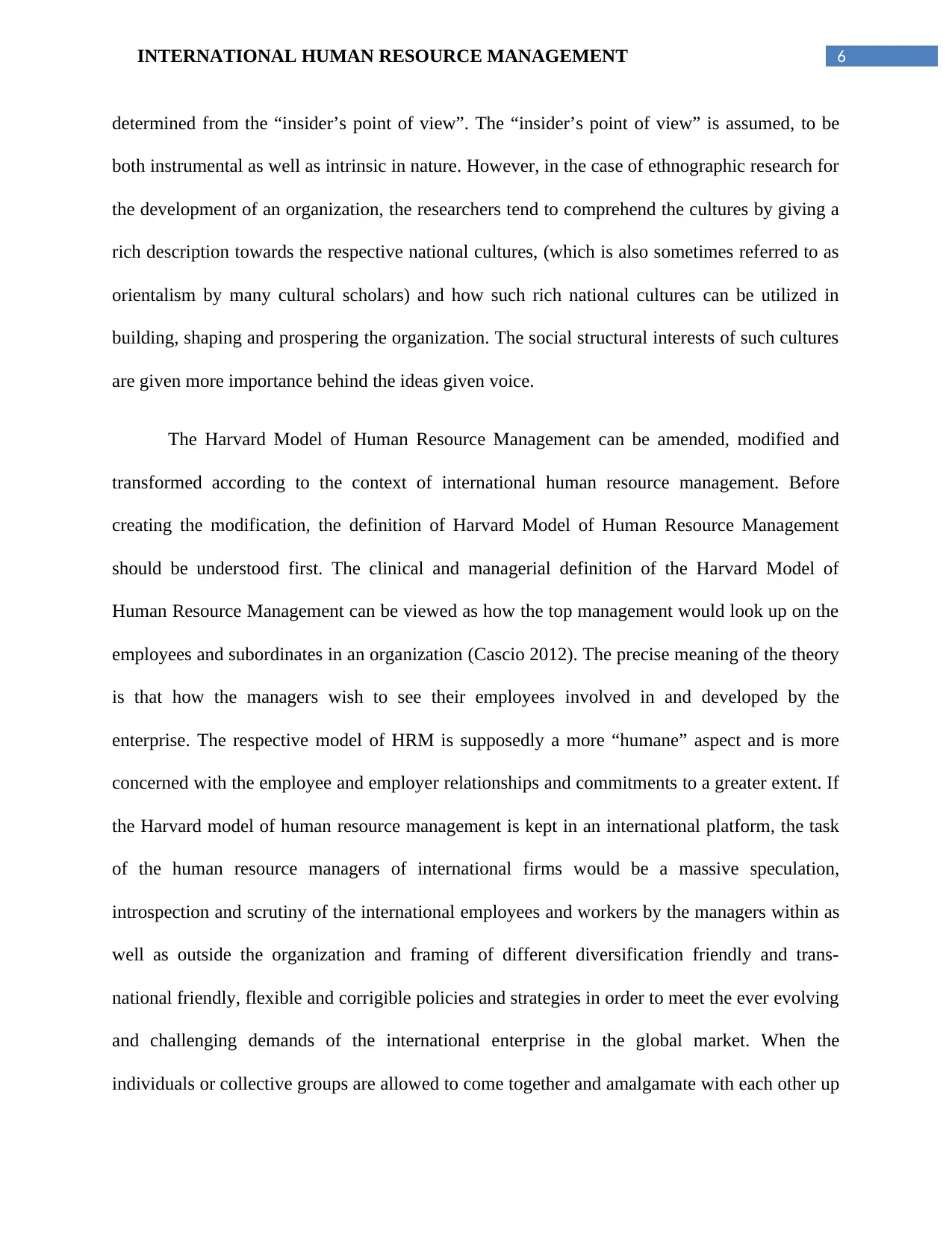
6INTERNATIONAL HUMAN RESOURCE MANAGEMENT
determined from the “insider’s point of view”. The “insider’s point of view” is assumed, to be
both instrumental as well as intrinsic in nature. However, in the case of ethnographic research for
the development of an organization, the researchers tend to comprehend the cultures by giving a
rich description towards the respective national cultures, (which is also sometimes referred to as
orientalism by many cultural scholars) and how such rich national cultures can be utilized in
building, shaping and prospering the organization. The social structural interests of such cultures
are given more importance behind the ideas given voice.
The Harvard Model of Human Resource Management can be amended, modified and
transformed according to the context of international human resource management. Before
creating the modification, the definition of Harvard Model of Human Resource Management
should be understood first. The clinical and managerial definition of the Harvard Model of
Human Resource Management can be viewed as how the top management would look up on the
employees and subordinates in an organization (Cascio 2012). The precise meaning of the theory
is that how the managers wish to see their employees involved in and developed by the
enterprise. The respective model of HRM is supposedly a more “humane” aspect and is more
concerned with the employee and employer relationships and commitments to a greater extent. If
the Harvard model of human resource management is kept in an international platform, the task
of the human resource managers of international firms would be a massive speculation,
introspection and scrutiny of the international employees and workers by the managers within as
well as outside the organization and framing of different diversification friendly and trans-
national friendly, flexible and corrigible policies and strategies in order to meet the ever evolving
and challenging demands of the international enterprise in the global market. When the
individuals or collective groups are allowed to come together and amalgamate with each other up
determined from the “insider’s point of view”. The “insider’s point of view” is assumed, to be
both instrumental as well as intrinsic in nature. However, in the case of ethnographic research for
the development of an organization, the researchers tend to comprehend the cultures by giving a
rich description towards the respective national cultures, (which is also sometimes referred to as
orientalism by many cultural scholars) and how such rich national cultures can be utilized in
building, shaping and prospering the organization. The social structural interests of such cultures
are given more importance behind the ideas given voice.
The Harvard Model of Human Resource Management can be amended, modified and
transformed according to the context of international human resource management. Before
creating the modification, the definition of Harvard Model of Human Resource Management
should be understood first. The clinical and managerial definition of the Harvard Model of
Human Resource Management can be viewed as how the top management would look up on the
employees and subordinates in an organization (Cascio 2012). The precise meaning of the theory
is that how the managers wish to see their employees involved in and developed by the
enterprise. The respective model of HRM is supposedly a more “humane” aspect and is more
concerned with the employee and employer relationships and commitments to a greater extent. If
the Harvard model of human resource management is kept in an international platform, the task
of the human resource managers of international firms would be a massive speculation,
introspection and scrutiny of the international employees and workers by the managers within as
well as outside the organization and framing of different diversification friendly and trans-
national friendly, flexible and corrigible policies and strategies in order to meet the ever evolving
and challenging demands of the international enterprise in the global market. When the
individuals or collective groups are allowed to come together and amalgamate with each other up
Paraphrase This Document
Need a fresh take? Get an instant paraphrase of this document with our AI Paraphraser
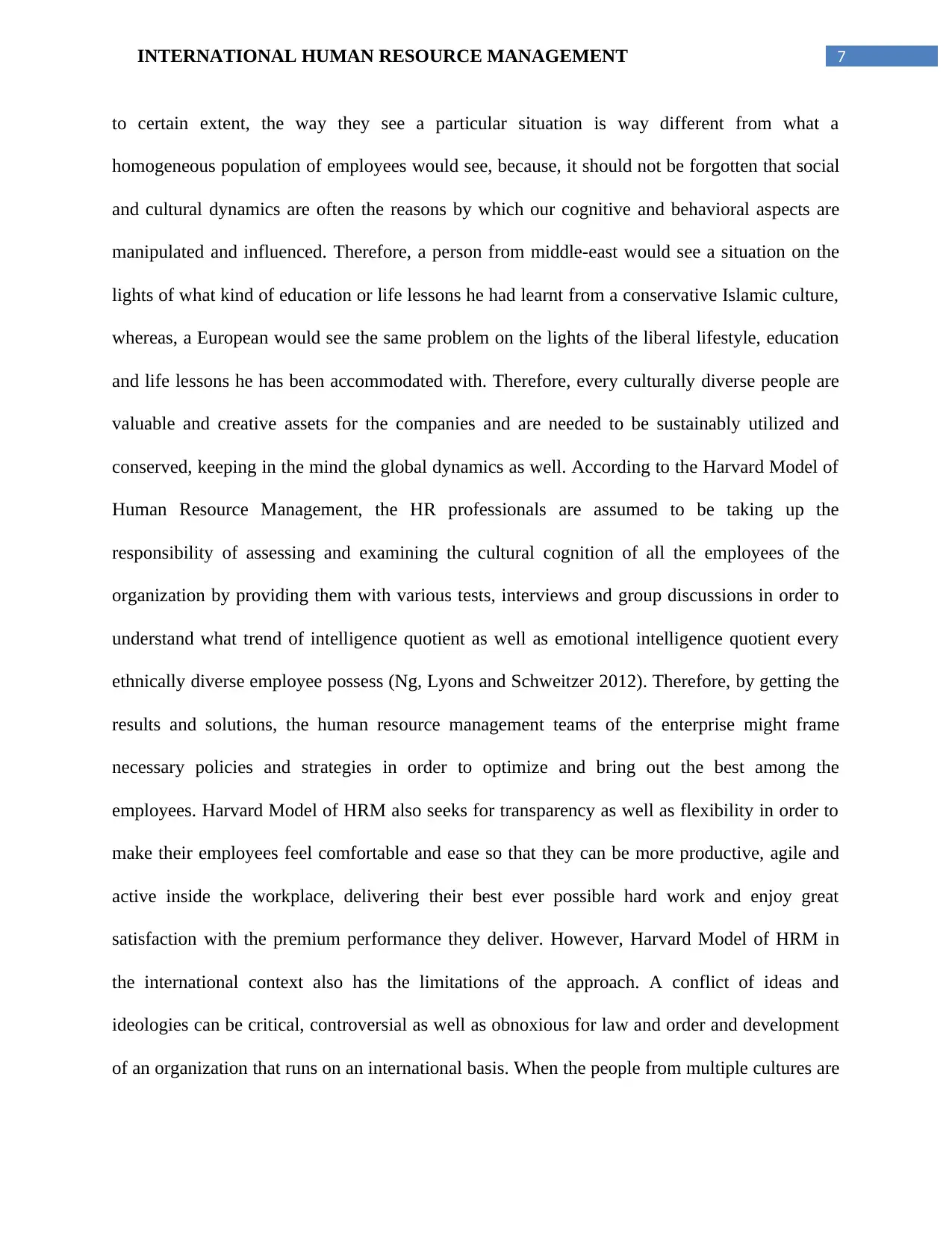
7INTERNATIONAL HUMAN RESOURCE MANAGEMENT
to certain extent, the way they see a particular situation is way different from what a
homogeneous population of employees would see, because, it should not be forgotten that social
and cultural dynamics are often the reasons by which our cognitive and behavioral aspects are
manipulated and influenced. Therefore, a person from middle-east would see a situation on the
lights of what kind of education or life lessons he had learnt from a conservative Islamic culture,
whereas, a European would see the same problem on the lights of the liberal lifestyle, education
and life lessons he has been accommodated with. Therefore, every culturally diverse people are
valuable and creative assets for the companies and are needed to be sustainably utilized and
conserved, keeping in the mind the global dynamics as well. According to the Harvard Model of
Human Resource Management, the HR professionals are assumed to be taking up the
responsibility of assessing and examining the cultural cognition of all the employees of the
organization by providing them with various tests, interviews and group discussions in order to
understand what trend of intelligence quotient as well as emotional intelligence quotient every
ethnically diverse employee possess (Ng, Lyons and Schweitzer 2012). Therefore, by getting the
results and solutions, the human resource management teams of the enterprise might frame
necessary policies and strategies in order to optimize and bring out the best among the
employees. Harvard Model of HRM also seeks for transparency as well as flexibility in order to
make their employees feel comfortable and ease so that they can be more productive, agile and
active inside the workplace, delivering their best ever possible hard work and enjoy great
satisfaction with the premium performance they deliver. However, Harvard Model of HRM in
the international context also has the limitations of the approach. A conflict of ideas and
ideologies can be critical, controversial as well as obnoxious for law and order and development
of an organization that runs on an international basis. When the people from multiple cultures are
to certain extent, the way they see a particular situation is way different from what a
homogeneous population of employees would see, because, it should not be forgotten that social
and cultural dynamics are often the reasons by which our cognitive and behavioral aspects are
manipulated and influenced. Therefore, a person from middle-east would see a situation on the
lights of what kind of education or life lessons he had learnt from a conservative Islamic culture,
whereas, a European would see the same problem on the lights of the liberal lifestyle, education
and life lessons he has been accommodated with. Therefore, every culturally diverse people are
valuable and creative assets for the companies and are needed to be sustainably utilized and
conserved, keeping in the mind the global dynamics as well. According to the Harvard Model of
Human Resource Management, the HR professionals are assumed to be taking up the
responsibility of assessing and examining the cultural cognition of all the employees of the
organization by providing them with various tests, interviews and group discussions in order to
understand what trend of intelligence quotient as well as emotional intelligence quotient every
ethnically diverse employee possess (Ng, Lyons and Schweitzer 2012). Therefore, by getting the
results and solutions, the human resource management teams of the enterprise might frame
necessary policies and strategies in order to optimize and bring out the best among the
employees. Harvard Model of HRM also seeks for transparency as well as flexibility in order to
make their employees feel comfortable and ease so that they can be more productive, agile and
active inside the workplace, delivering their best ever possible hard work and enjoy great
satisfaction with the premium performance they deliver. However, Harvard Model of HRM in
the international context also has the limitations of the approach. A conflict of ideas and
ideologies can be critical, controversial as well as obnoxious for law and order and development
of an organization that runs on an international basis. When the people from multiple cultures are
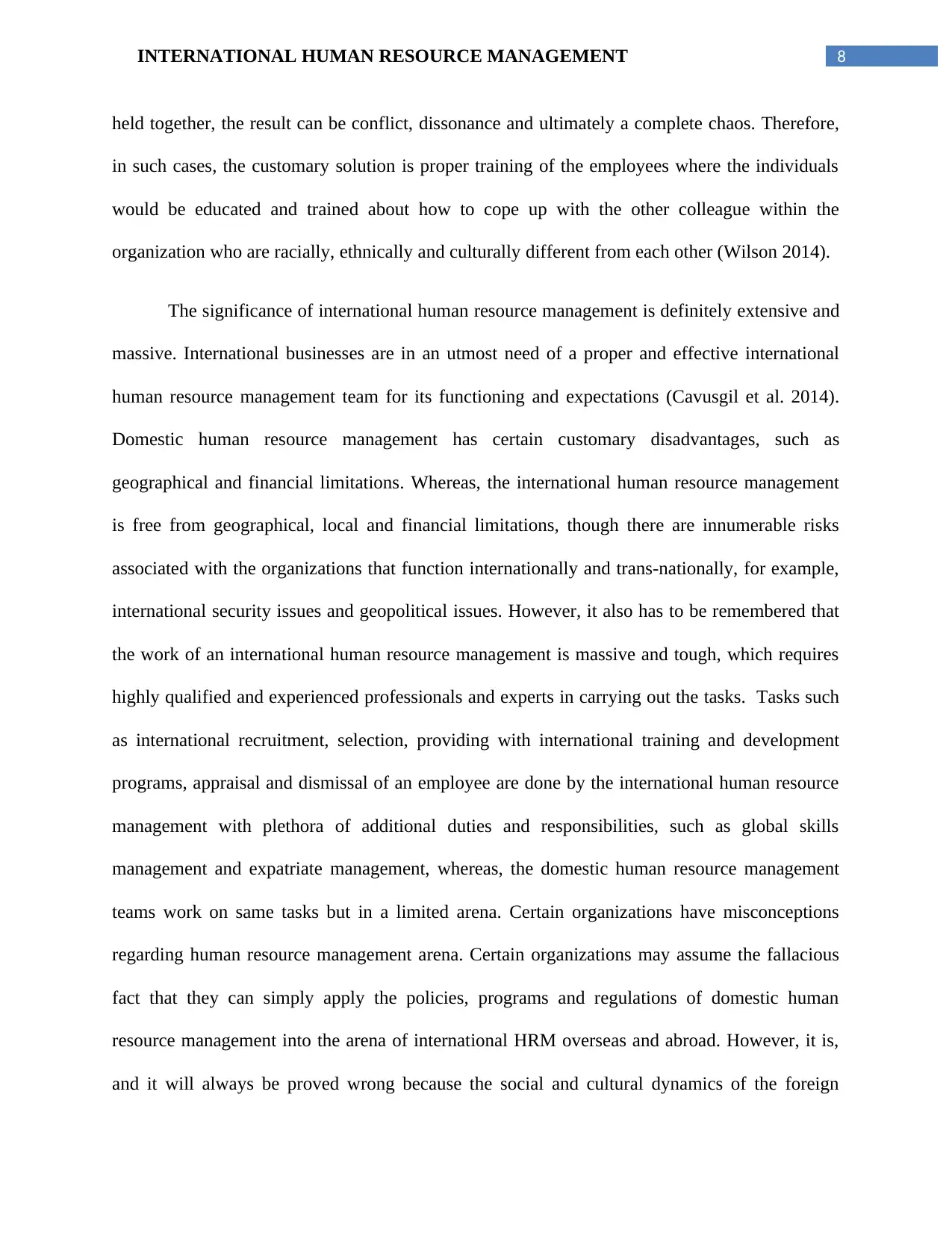
8INTERNATIONAL HUMAN RESOURCE MANAGEMENT
held together, the result can be conflict, dissonance and ultimately a complete chaos. Therefore,
in such cases, the customary solution is proper training of the employees where the individuals
would be educated and trained about how to cope up with the other colleague within the
organization who are racially, ethnically and culturally different from each other (Wilson 2014).
The significance of international human resource management is definitely extensive and
massive. International businesses are in an utmost need of a proper and effective international
human resource management team for its functioning and expectations (Cavusgil et al. 2014).
Domestic human resource management has certain customary disadvantages, such as
geographical and financial limitations. Whereas, the international human resource management
is free from geographical, local and financial limitations, though there are innumerable risks
associated with the organizations that function internationally and trans-nationally, for example,
international security issues and geopolitical issues. However, it also has to be remembered that
the work of an international human resource management is massive and tough, which requires
highly qualified and experienced professionals and experts in carrying out the tasks. Tasks such
as international recruitment, selection, providing with international training and development
programs, appraisal and dismissal of an employee are done by the international human resource
management with plethora of additional duties and responsibilities, such as global skills
management and expatriate management, whereas, the domestic human resource management
teams work on same tasks but in a limited arena. Certain organizations have misconceptions
regarding human resource management arena. Certain organizations may assume the fallacious
fact that they can simply apply the policies, programs and regulations of domestic human
resource management into the arena of international HRM overseas and abroad. However, it is,
and it will always be proved wrong because the social and cultural dynamics of the foreign
held together, the result can be conflict, dissonance and ultimately a complete chaos. Therefore,
in such cases, the customary solution is proper training of the employees where the individuals
would be educated and trained about how to cope up with the other colleague within the
organization who are racially, ethnically and culturally different from each other (Wilson 2014).
The significance of international human resource management is definitely extensive and
massive. International businesses are in an utmost need of a proper and effective international
human resource management team for its functioning and expectations (Cavusgil et al. 2014).
Domestic human resource management has certain customary disadvantages, such as
geographical and financial limitations. Whereas, the international human resource management
is free from geographical, local and financial limitations, though there are innumerable risks
associated with the organizations that function internationally and trans-nationally, for example,
international security issues and geopolitical issues. However, it also has to be remembered that
the work of an international human resource management is massive and tough, which requires
highly qualified and experienced professionals and experts in carrying out the tasks. Tasks such
as international recruitment, selection, providing with international training and development
programs, appraisal and dismissal of an employee are done by the international human resource
management with plethora of additional duties and responsibilities, such as global skills
management and expatriate management, whereas, the domestic human resource management
teams work on same tasks but in a limited arena. Certain organizations have misconceptions
regarding human resource management arena. Certain organizations may assume the fallacious
fact that they can simply apply the policies, programs and regulations of domestic human
resource management into the arena of international HRM overseas and abroad. However, it is,
and it will always be proved wrong because the social and cultural dynamics of the foreign
⊘ This is a preview!⊘
Do you want full access?
Subscribe today to unlock all pages.

Trusted by 1+ million students worldwide
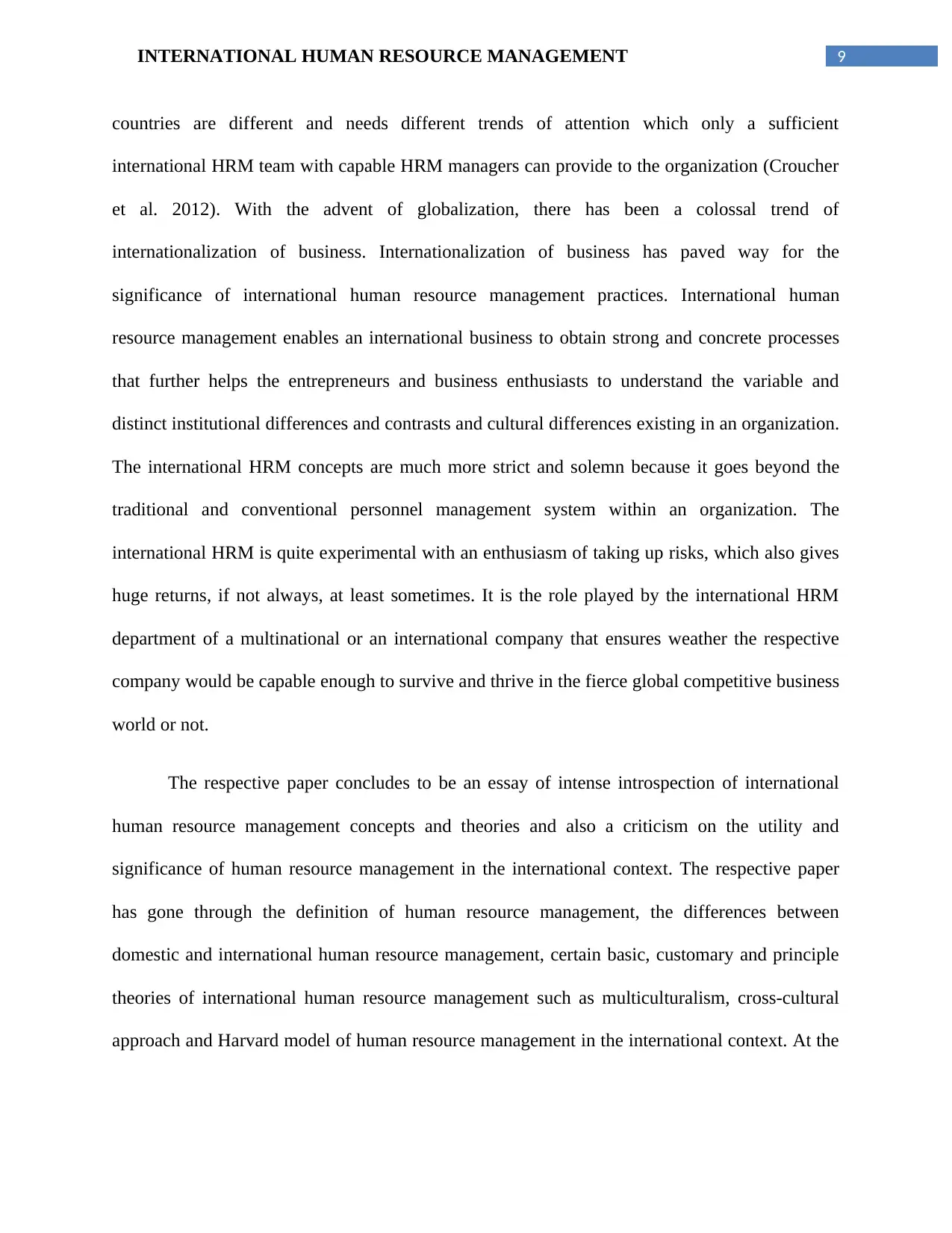
9INTERNATIONAL HUMAN RESOURCE MANAGEMENT
countries are different and needs different trends of attention which only a sufficient
international HRM team with capable HRM managers can provide to the organization (Croucher
et al. 2012). With the advent of globalization, there has been a colossal trend of
internationalization of business. Internationalization of business has paved way for the
significance of international human resource management practices. International human
resource management enables an international business to obtain strong and concrete processes
that further helps the entrepreneurs and business enthusiasts to understand the variable and
distinct institutional differences and contrasts and cultural differences existing in an organization.
The international HRM concepts are much more strict and solemn because it goes beyond the
traditional and conventional personnel management system within an organization. The
international HRM is quite experimental with an enthusiasm of taking up risks, which also gives
huge returns, if not always, at least sometimes. It is the role played by the international HRM
department of a multinational or an international company that ensures weather the respective
company would be capable enough to survive and thrive in the fierce global competitive business
world or not.
The respective paper concludes to be an essay of intense introspection of international
human resource management concepts and theories and also a criticism on the utility and
significance of human resource management in the international context. The respective paper
has gone through the definition of human resource management, the differences between
domestic and international human resource management, certain basic, customary and principle
theories of international human resource management such as multiculturalism, cross-cultural
approach and Harvard model of human resource management in the international context. At the
countries are different and needs different trends of attention which only a sufficient
international HRM team with capable HRM managers can provide to the organization (Croucher
et al. 2012). With the advent of globalization, there has been a colossal trend of
internationalization of business. Internationalization of business has paved way for the
significance of international human resource management practices. International human
resource management enables an international business to obtain strong and concrete processes
that further helps the entrepreneurs and business enthusiasts to understand the variable and
distinct institutional differences and contrasts and cultural differences existing in an organization.
The international HRM concepts are much more strict and solemn because it goes beyond the
traditional and conventional personnel management system within an organization. The
international HRM is quite experimental with an enthusiasm of taking up risks, which also gives
huge returns, if not always, at least sometimes. It is the role played by the international HRM
department of a multinational or an international company that ensures weather the respective
company would be capable enough to survive and thrive in the fierce global competitive business
world or not.
The respective paper concludes to be an essay of intense introspection of international
human resource management concepts and theories and also a criticism on the utility and
significance of human resource management in the international context. The respective paper
has gone through the definition of human resource management, the differences between
domestic and international human resource management, certain basic, customary and principle
theories of international human resource management such as multiculturalism, cross-cultural
approach and Harvard model of human resource management in the international context. At the
Paraphrase This Document
Need a fresh take? Get an instant paraphrase of this document with our AI Paraphraser
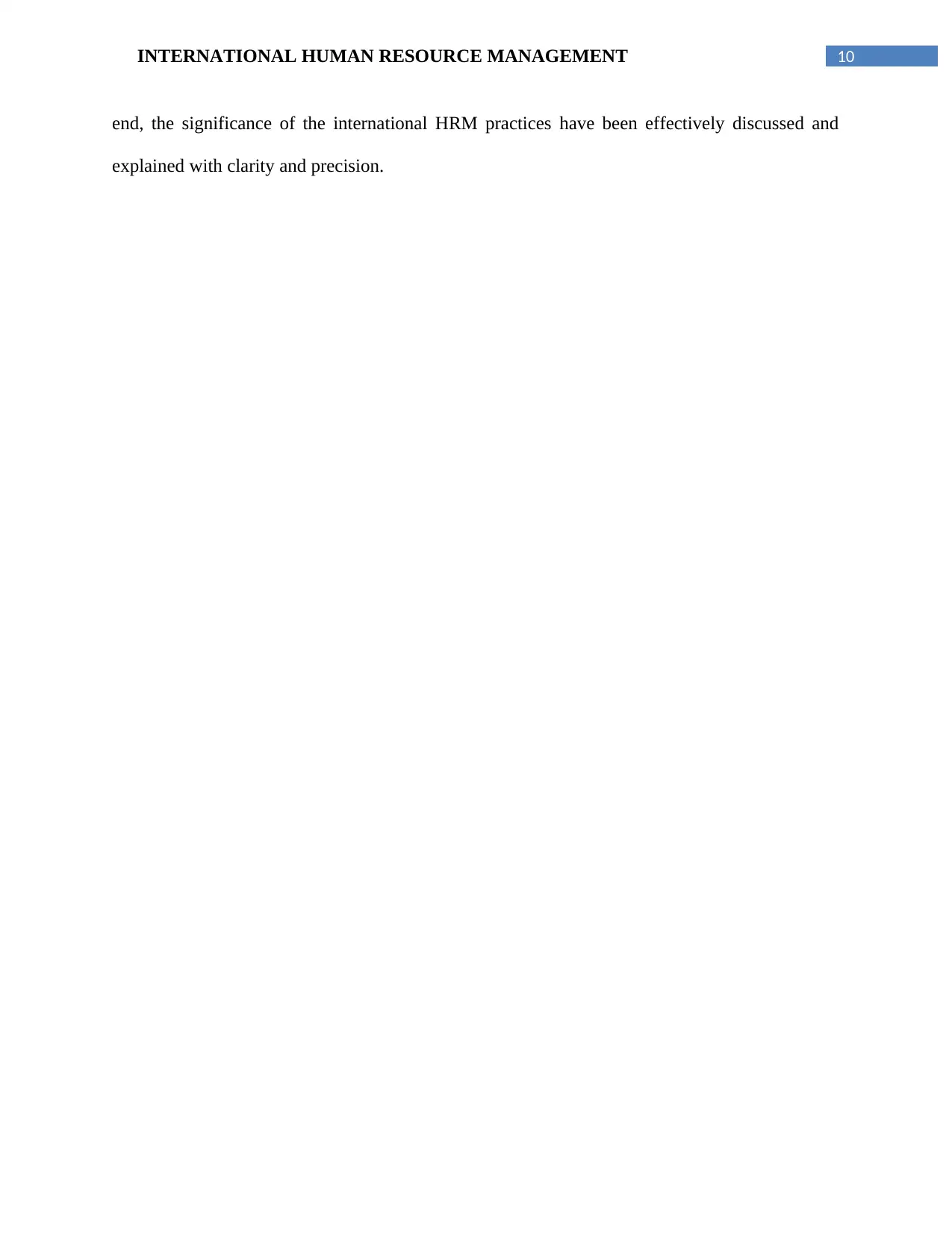
10INTERNATIONAL HUMAN RESOURCE MANAGEMENT
end, the significance of the international HRM practices have been effectively discussed and
explained with clarity and precision.
end, the significance of the international HRM practices have been effectively discussed and
explained with clarity and precision.
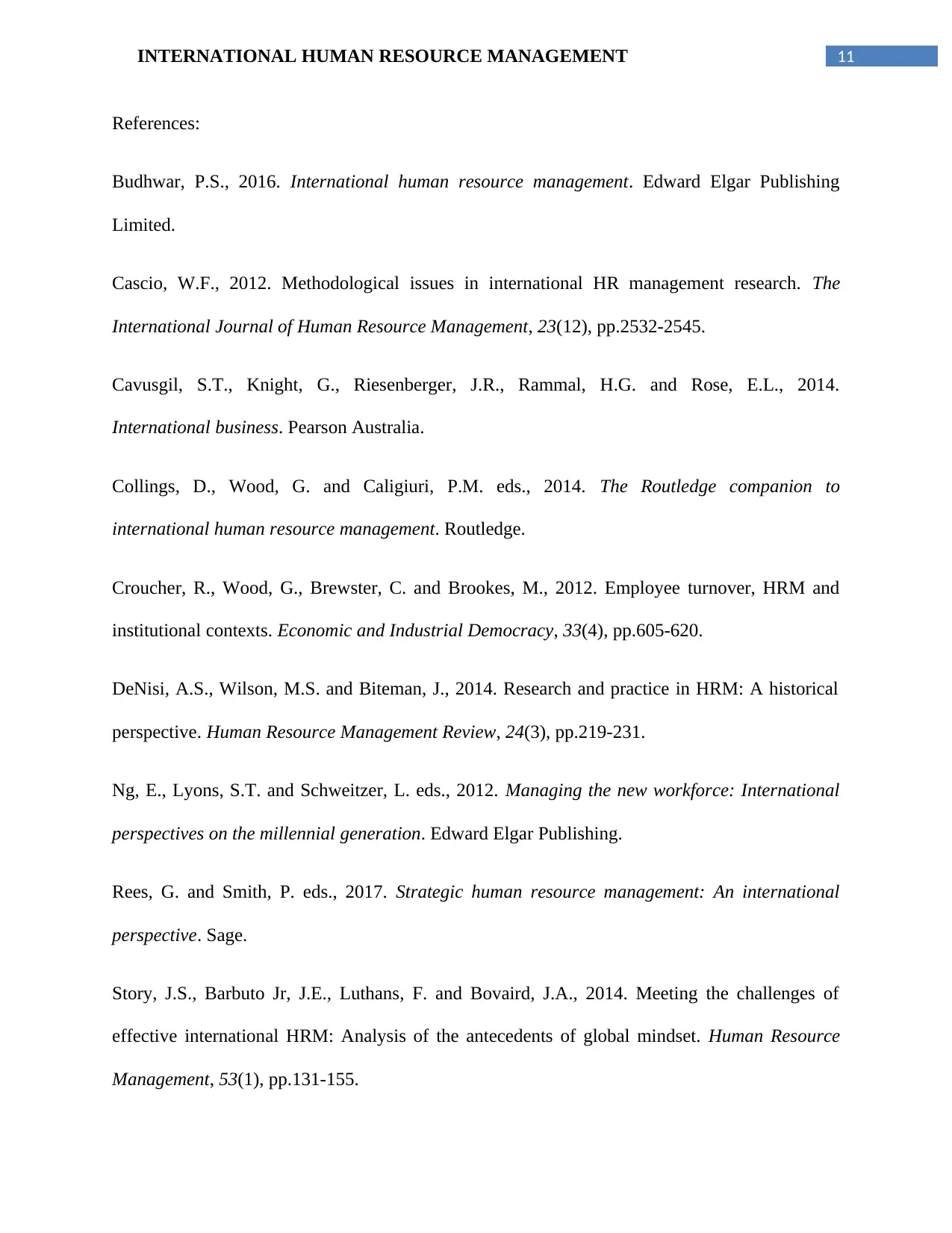
11INTERNATIONAL HUMAN RESOURCE MANAGEMENT
References:
Budhwar, P.S., 2016. International human resource management. Edward Elgar Publishing
Limited.
Cascio, W.F., 2012. Methodological issues in international HR management research. The
International Journal of Human Resource Management, 23(12), pp.2532-2545.
Cavusgil, S.T., Knight, G., Riesenberger, J.R., Rammal, H.G. and Rose, E.L., 2014.
International business. Pearson Australia.
Collings, D., Wood, G. and Caligiuri, P.M. eds., 2014. The Routledge companion to
international human resource management. Routledge.
Croucher, R., Wood, G., Brewster, C. and Brookes, M., 2012. Employee turnover, HRM and
institutional contexts. Economic and Industrial Democracy, 33(4), pp.605-620.
DeNisi, A.S., Wilson, M.S. and Biteman, J., 2014. Research and practice in HRM: A historical
perspective. Human Resource Management Review, 24(3), pp.219-231.
Ng, E., Lyons, S.T. and Schweitzer, L. eds., 2012. Managing the new workforce: International
perspectives on the millennial generation. Edward Elgar Publishing.
Rees, G. and Smith, P. eds., 2017. Strategic human resource management: An international
perspective. Sage.
Story, J.S., Barbuto Jr, J.E., Luthans, F. and Bovaird, J.A., 2014. Meeting the challenges of
effective international HRM: Analysis of the antecedents of global mindset. Human Resource
Management, 53(1), pp.131-155.
References:
Budhwar, P.S., 2016. International human resource management. Edward Elgar Publishing
Limited.
Cascio, W.F., 2012. Methodological issues in international HR management research. The
International Journal of Human Resource Management, 23(12), pp.2532-2545.
Cavusgil, S.T., Knight, G., Riesenberger, J.R., Rammal, H.G. and Rose, E.L., 2014.
International business. Pearson Australia.
Collings, D., Wood, G. and Caligiuri, P.M. eds., 2014. The Routledge companion to
international human resource management. Routledge.
Croucher, R., Wood, G., Brewster, C. and Brookes, M., 2012. Employee turnover, HRM and
institutional contexts. Economic and Industrial Democracy, 33(4), pp.605-620.
DeNisi, A.S., Wilson, M.S. and Biteman, J., 2014. Research and practice in HRM: A historical
perspective. Human Resource Management Review, 24(3), pp.219-231.
Ng, E., Lyons, S.T. and Schweitzer, L. eds., 2012. Managing the new workforce: International
perspectives on the millennial generation. Edward Elgar Publishing.
Rees, G. and Smith, P. eds., 2017. Strategic human resource management: An international
perspective. Sage.
Story, J.S., Barbuto Jr, J.E., Luthans, F. and Bovaird, J.A., 2014. Meeting the challenges of
effective international HRM: Analysis of the antecedents of global mindset. Human Resource
Management, 53(1), pp.131-155.
⊘ This is a preview!⊘
Do you want full access?
Subscribe today to unlock all pages.

Trusted by 1+ million students worldwide
1 out of 13
Related Documents
Your All-in-One AI-Powered Toolkit for Academic Success.
+13062052269
info@desklib.com
Available 24*7 on WhatsApp / Email
![[object Object]](/_next/static/media/star-bottom.7253800d.svg)
Unlock your academic potential
Copyright © 2020–2025 A2Z Services. All Rights Reserved. Developed and managed by ZUCOL.




